North America was once home to many large mammals,known as megafauna, which became extinct at the end of the last Ice Age: the glacial maximum occurred about 20,000 to 18,000 years ago.By about 15,500 years ago, many of the large mammals were beginning to disappear in what is called the Pleistocene extinction. The mammals which went extinct at this time included saber-tooth cats, camels, mammoths, mastodons, giant short-faced bears, ground sloths, and dire wolves.
By 800,000 years ago, there were two short-faced bears in North America: the giant short-faced bear (Arctodus simus) and the lesser short-faced bear (Arctodus pristinus). The giant short-faced bear is considered to bethe largest terrestrial mammalian carnivores that every existed.
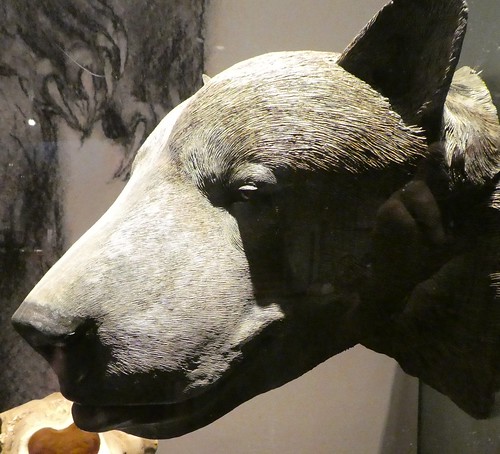 Shown above is a sculpture by David L. Might on display in the Ohio History Center in Columbus, Ohio.
Shown above is a sculpture by David L. Might on display in the Ohio History Center in Columbus, Ohio.
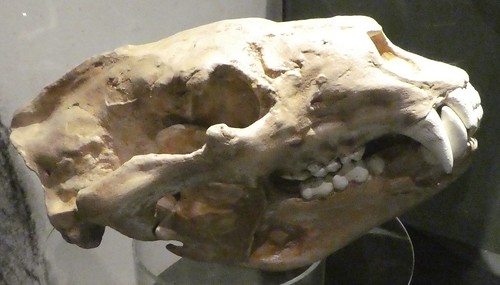 Shown above is a cast of the skull of a giant short-faced bear on display in the Ohio History Center.
Shown above is a cast of the skull of a giant short-faced bear on display in the Ohio History Center.
In his book Ice Age Mammals of North America, Ian Lange explains the designation “short-faced”:
“Their snouts appear short relative to the size of their heads—thus, the name ‘short-faced’ bear. The width of the giant’s skull was 80 percent of the skull’s length. With short faces and wide muzzles, the skulls of the two species resemble that of a big cat.”
The lesser short-faced bear lived in what is now the eastern United States and south into Mexico. This animal became extinct about 20,000 years ago.
The giant short-faced bear lived west of the Mississippi River, ranging from Alaska and Yukon in the north to Mexico in the south. This animal became extinct about 20,000 years ago.
The giant short-faced bears (Arctodus simus) had short bodies in relation to their long legs. They had a keen sense of smell. Today’s grizzly, which stands 4 feet tall at the shoulder, appears short next to the short-faced bear which stood 5.5 feet tall at the shoulder. Ian Lange reports:
“At 5.5 feet tall (1.68 meters) and almost 10 feet (3 meters) long, the giant short-faced bear would dwarf the modern grizzly, which measures up to 4 feet (over 1 meter) tall and 9 feet (2.74 meters) long. When standing on their hind feet, the top of their head was more than 11 feet (3.4 meters high).”
In comparison with the grizzly, the giant short-faced bear was about a foot taller than the grizzly and about twice its weight.
The male giant short-faced bear is estimated to have weighed about a ton. Females were smaller than males. The male lesser short-faced bear weighed about 1,200 pounds. Researchers have found that this bear was carnivorous, and the data suggests that it was probably a scavenger, which may have contributed to its extinction.
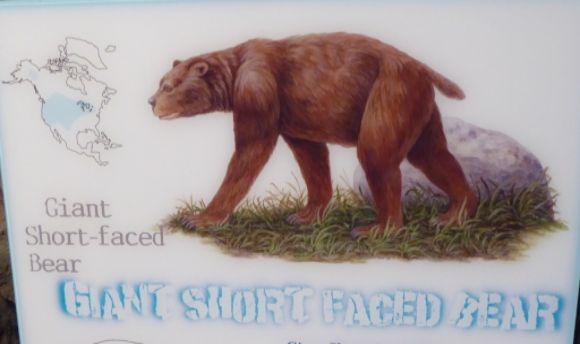 Shown above is an illustration of the giant short-faced bear in the Columbia Gorge Discovery Center in The Dalles, Oregon.
Shown above is an illustration of the giant short-faced bear in the Columbia Gorge Discovery Center in The Dalles, Oregon.
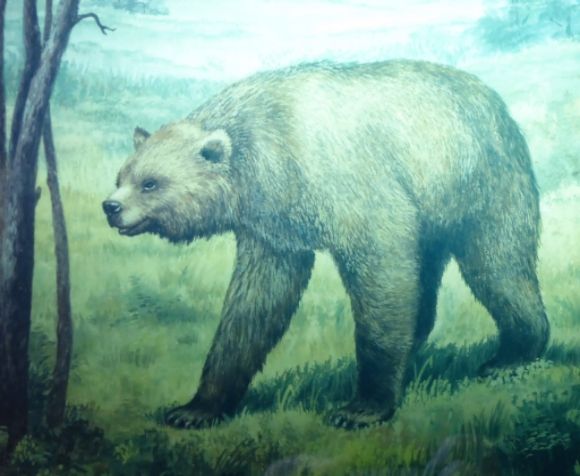 Shown above is an illustration of the giant short-faced bear in the La Brea Tar Pits Museum in Los Angeles.
Shown above is an illustration of the giant short-faced bear in the La Brea Tar Pits Museum in Los Angeles.
According to the La Brea Tar Pits Museum display:
“Unlike most bears, this mammal lived almost exclusively on meat, running down its prey or scavenging from other predators. Its closest living relative is the spectacled bear from South America.”
It has been estimated that the giant short-faced bear was able to run 30-40 mph and therefore could run down herbivores such as horses and saiga antelopes. There is also some evidence that could bring down large mammals such as the mastodon.
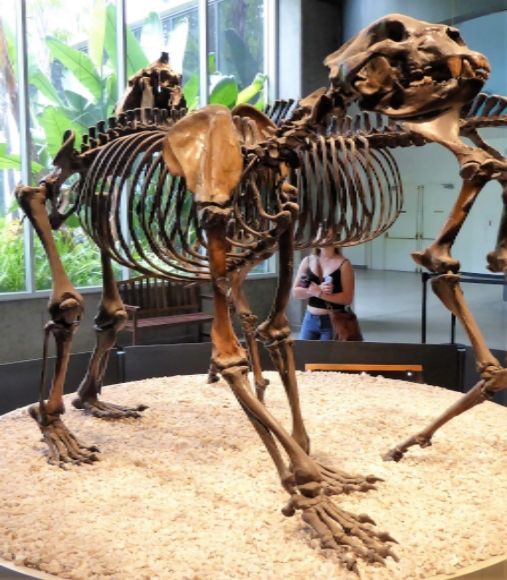 Shown above is the skeleton of the giant short-faced bear on display in the La Brea Tar Pits Museum.
Shown above is the skeleton of the giant short-faced bear on display in the La Brea Tar Pits Museum.
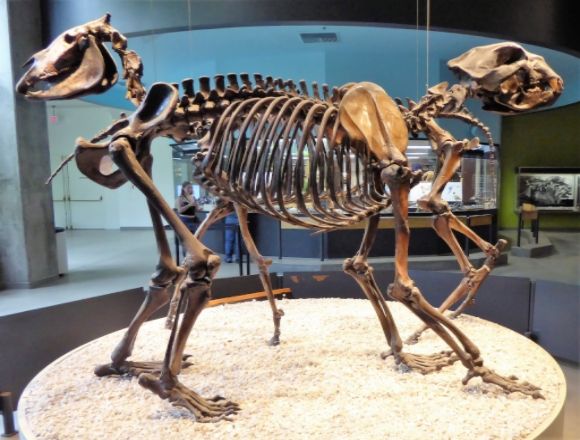 Shown above is a giant short-faced bear standing next to the Western Horse in the La Brea Tar Pits Museum.
Shown above is a giant short-faced bear standing next to the Western Horse in the La Brea Tar Pits Museum.
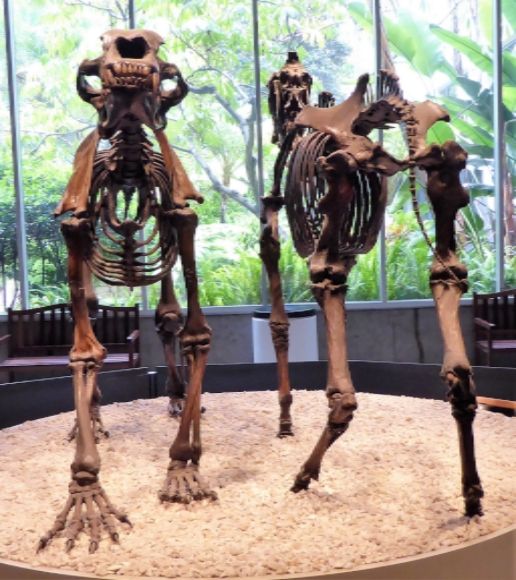 Another view of the giant short-faced bear standing next to the Western Horse.
Another view of the giant short-faced bear standing next to the Western Horse.
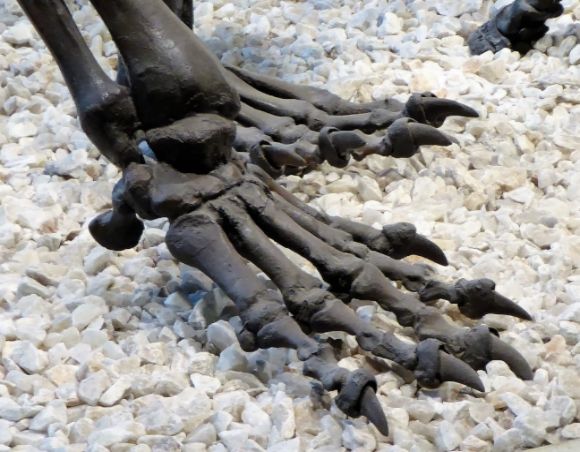 Shown above are the front paws of the giant short-faced bear on display in the La Brea Tar Pits Museum.
Shown above are the front paws of the giant short-faced bear on display in the La Brea Tar Pits Museum.
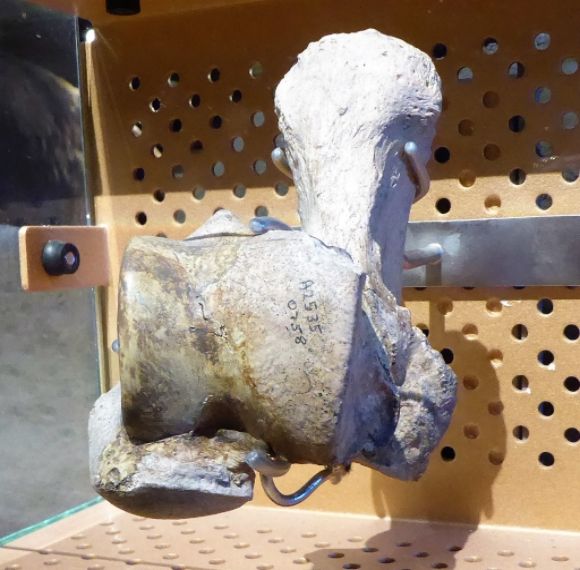 Shown above is the ankle bone of the giant short-faced bear which is on display in the San Bernardino County Museum in Redlands, California.
Shown above is the ankle bone of the giant short-faced bear which is on display in the San Bernardino County Museum in Redlands, California.
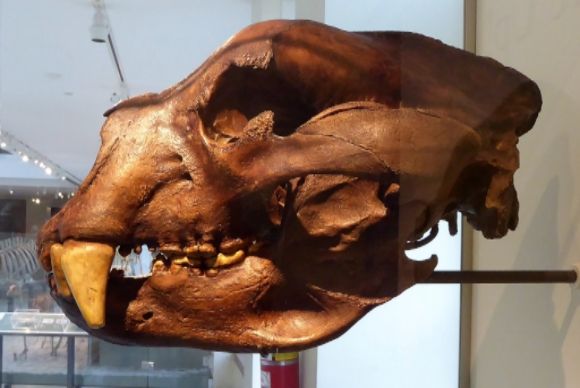 Shown above is the skull of a giant short-faced bear which is on display in the Los Angeles County Natural History Museum in Los Angeles.
Shown above is the skull of a giant short-faced bear which is on display in the Los Angeles County Natural History Museum in Los Angeles.
According to the Los Angeles County Natural History Museum display:
“Unlike most bears, this mammal lived almost exclusively on meat, running down its prey or scavenging from other predators. Its closest living relative is the spectacled bear from South America.”
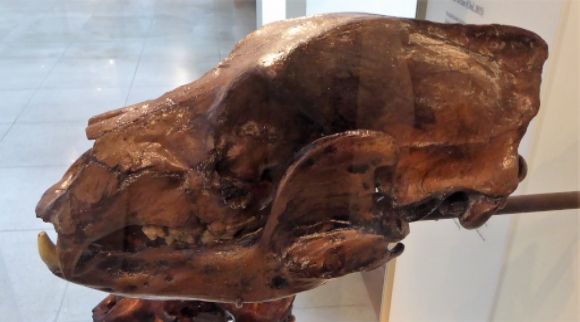 Shown above is the skull of a grizzly bear which is on display in the Los Angeles County Natural History Museum.
Shown above is the skull of a grizzly bear which is on display in the Los Angeles County Natural History Museum.
About 50,000 years ago, the grizzly bear (Ursus arctos) arrived in Alaska from Siberia. Grizzlies did not move south of the ice sheets until the end of the Pleistocene.
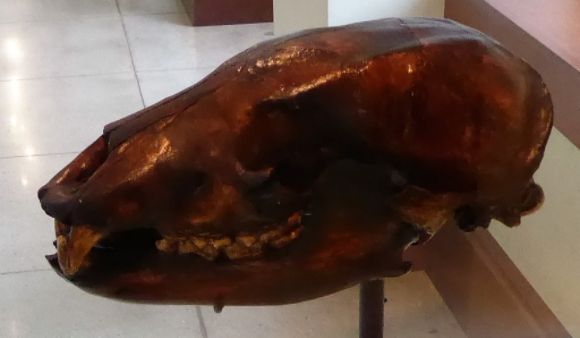 Shown above is the skull of a black bear which is on display in the Los Angeles County Natural History Museum.
Shown above is the skull of a black bear which is on display in the Los Angeles County Natural History Museum.
During the early Pleistocene, black bears (Ursus americanus) arrived in North America. Black bears are omnivores.
American Indians
Archaeologists have uncovered the remains of the giant short-faced bear along with Indian artifacts in the Sheriden Cave site in Ohio. The evidence from this site, which dates to about 11,000 BCE suggests that the bear was hunted. The Indian people at this site also hunted stagmoose (Cervalces scotti), an animal that resembled modern moose except for its forked antlers; giant beaver, (Castoroides ohioensis), an animal that reached up to nine feet in length; flat-headed peccary, (Platygonus compressus) the wide-ranging American pig of the Pleistocene; and caribou (Rangifer tarandus).
More Ancient America
Ancient America: Mastodons (revised)
Ancient America: Mammoths
Ancient America: The Pleistocene Extinctions
Ancient America: North American Camels
Ancient America: A very brief overview of stone quarries
Ancient America: Methow Indian rock art (photo diary)
Ancient America: Avonlea, the early bow hunters
Ancient America: Florida, 1000 CE to 1300 CE


